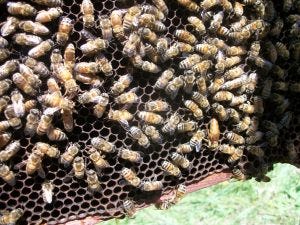A Bump of Direction

The girls, hard at work - my Dad's honeybees.
This year's Nobel prize for Medicine was awarded to a three-man team who made the interesting discovery that rats have what they call a built-in GPS. It seems that it's been known for a long time that rats have built-in maps in their brain, cells in the hippocampus which activate as the creature navigates through a place it has already been. This team built on that research, discovering that there is a two-dimensional grid of neurons in the brain that tells the brain where you are going, and where you have been. The cells seem to be linked to sights, smells, and experiences, not places alone. Although the headlines trumpet that this means humans have the ability to do the same thing, the research isn't there quite yet.
I think we all know people who get lost as soon as they leave their house. I was talking with my friend Kate Paulk about this article yesterday, and she pointed out that moving from Australia to America, and changing hemispheres, played merry havoc with her own internal navigation systems. The sun's angle had completely changed. I know that simply moving from New Hampshire to Ohio threw me off for close to a year, and I'm only talking about stepping outside the house and orienting myself by the sun, which is more or less in the same angle it was there. I can't imagine upending myself on the globe and what that would do.
It seems that the cells must be previously activated by actions - in other words, they have to have been there before, to have a map. Unlike rats, honeybees can get where they are going without having to have been there before. The dances of the honeybees are famous for being non-verbal directions, but how do the bees know how far they must go? The answer lies in their magnetic navigation system.
Honeybees are aligned to the earth's magnetic field. My Dad, who is a master beekeeper and has been reading and studying about them for more than twenty years now, explained to me that they collect iron-rich particles somewhere under their chin, and this allows them to sense the magnetic field. Scientists studying this discovered that changes to that iron releases intracellular calcium, which sends signals to the bee's brain on a cellular level, enabling that amazing internal GPS to keep them on track. Humans don't have this level of connection to the Earth, as anyone who has tried to find their car again in a crowded mall parking lot can attest.
The magnetic system of the bees might be part of an answer a friend who writes Science Fiction asked a while back. I sent him to my Dad for more answers, but to keep bees in space, you would want to create a mini-magnetic field. And keeping bees would be important if you wanted to set up a self-sustaining space station or roving habitat, and not just for the honey, but the pollination. Trust me when I assure you that you do not want to hand-pollinate enough plants to feed any size of a community.
It ought to be interesting to see what happens when we finally get established in space, to keep bees and other animals which share that magnetoactic navigation system, how we must design and build the habitats. I learned in microbiology class a couple of weeks ago that certain micro-organisms also navigate with magnetism. Humans, on the other hand, have to rely on their brains, and previous experiences blended with reading current surroundings to predict what will come at them next. It will be fascinating to find out what our internal maps look like, and how they are influenced. Smells? Sounds? I know we located a donut shop in Wales once by using smell, and a deduction...
I was 18 and traveling overseas. Dad and I had been tasked with finding morning pastries, and given vague directions. We could tell we were near the shop, we could smell it, and our growling stomachs were demanding we locate it soon, or else. As we strolled down the street, we were overtaken by a pair of bobbies. Dad looked at me, and I remember laughing, as we followed them. And yes, they did lead us straight into the shop!



